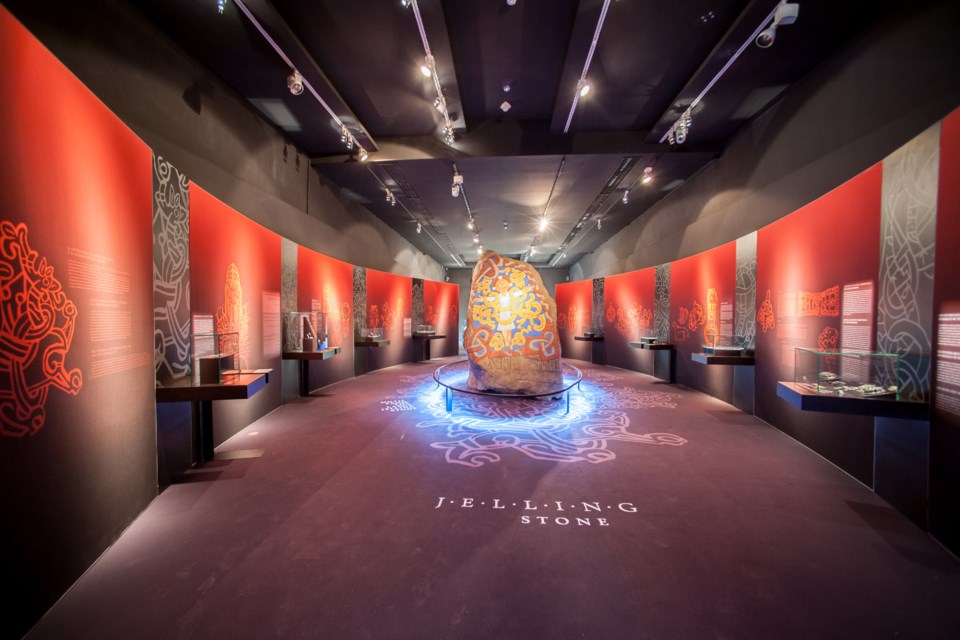PREVIEW
Vikings: Beyond the Legend
Runs until Oct. 20
Royal Alberta Museum
9810 103A Ave., Edmonton
Tickets: Adult $19, Senior $14, Youth $10 and child under six free
A surprising thing about Vikings is that they didn’t call themselves that. Being a Viking was not an ethnic group. It was what one did on a trip – “to go on a viking.”
Here in North America, the image we conjure up is dirty, bloodthirsty raiders wielding swords and wearing a helmet with horns.
Archeologists have never discovered helmets with horns. It was Richard Wagner and his costume designer who incorporated horns to the German composer’s opera cycles.
Movies and television programs such as Vikings continue the mystique. However, Vikings: Beyond the Legend, now showcased at Royal Alberta Museum until Oct. 20, proudly displays 650 artifacts roughly dated from 750 to 1100.
On loan from the National Museum of Denmark, the artifacts are a cultural representation of the society from the most powerful to the lowliest.
Together they dispel the stereotypes and focus a lens on a layered Scandinavian society composed of kings, nobles, landowners and full-time sailors to warriors, farmers, craftspeople, hunters, traders and slaves.
Divided into eight sections in the 30,000-square-foot feature gallery, the artifacts (all under glass showcases) wind their way through ship building techniques, styles of swords and weaponry, trading and blacksmithing, craft making, jewelry, agricultural tools, textiles, clothes, styles of houses, leisure activities, as well as gods and beliefs.
The most dramatic is the skeleton replica of Roskilde 6, a ship built for speed that carried up to 100 warriors. The original, excavated in 1996 at Roskilde Fjord with 25 per cent of the oak wood still intact, is the longest Viking ship ever found. Throughout the replica ship’s 122-foot length, some of the original wood slats are still visible.
The original ship was built around 1025 CE with 39 pairs of oars for 78 rowers for the fast movement of troops or quick getaways after pillaging a coastal area.
Only kings and earls could afford to build ships using oak, the best and most durable material available. Canute the Great, King of Denmark, Norway and part of Sweden, ruled throughout 1014 to 1035 CE and quite possibly this ship was part of his fleet.
Another equally stunning showpiece is a replica burial boat excavated in 1880 at Gokstad, Norway. A Viking male approximately 40 to 50 years old who died in battle was buried in 79-foot-long ship. It is believed he was a great warrior.
Similar to the Egyptian practice of providing kings and nobles with all the essentials for the after life, archeologists also found gold-embroidered tapestries, a sleigh, six beds, a chest, eating and drinking utensils, a saddle, 64 shields, 12 horses, eight dogs, two hawks and two peacocks.
Although Vikings were sea marauders that sailed up the coast to Russia and eventually made their way to Asia for trade purposes, the society as a whole was rooted in cultural traditions.
The family farm was basic to society providing meat, vegetables, and wool for weaving and sewing simple clothing. Several glass showcases exhibit pliers, files, a hammer’s head, sickles, keys and an axe head whose designs are surprisingly similar to modern ones available at the hardware store.
While blacksmiths forged weapons for battle, tools for working, nails for building and utensils for eating, bonesmiths were also highly prized for carving ice skates, tool hands and combs.
Among the artifacts on display is an entire area devoted to jewelry fashioned form a variety of materials including gold, silver and bronze. Vikings were close to nature and much of their jewelry celebrated animals such as horses, lions, birds, snakes and cats. Blacksmiths and goldsmiths also favoured geometric patterns, knots and ornamental leaves.
Depending on rank, a man or woman could sport sinuous arm bracelets forged from gold or simple twisted rings made from silver or bronze. Even prized animals were decorated according to their stature. One showcased displays a horse’s bronze harness bow with two fully molded wolves heads at each end.
More than just warriors, Vikings were a society that developed highly skilled craftspeople creatively working with textiles, wood, metal, bone, leather, glass and clay to create essentials and decoration for both domestic life and battle.
The exhibit is packed with touch screens and interactive displays. One interactive display that attracted everyone was a traditional 35-inch Viking sword that could be picked up to assess weight and balance. Unfortunately, it was impossible to wield since it was attached to a table.
Another interactive display was a reality rowing experience where visitors could use physical replica oars to test their ability to maintain a rowing rhythm necessary to move a Viking ship. It's not as easy as it looks.
From the Vikings prowess on the seas to their conversion to Christianity, Vikings: Beyond the Legend provides an insightful look into a long-gone society, but one that forever made its mark in history.



